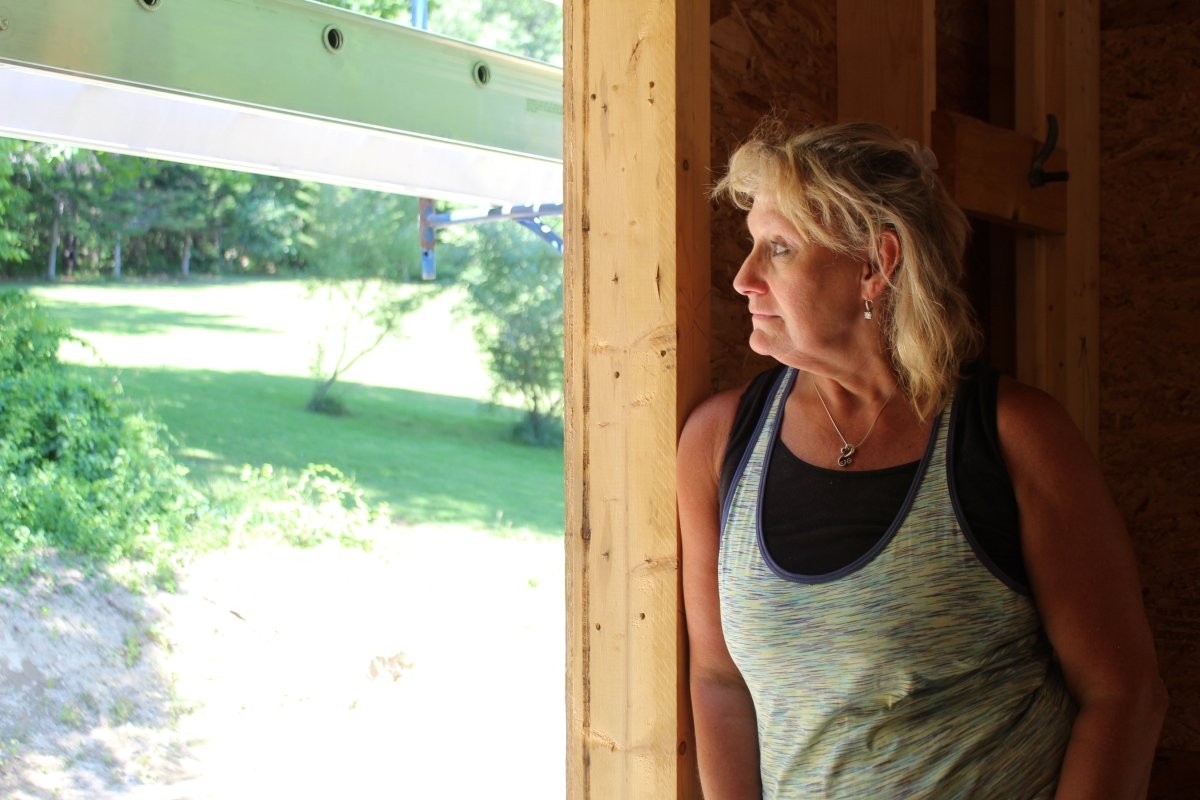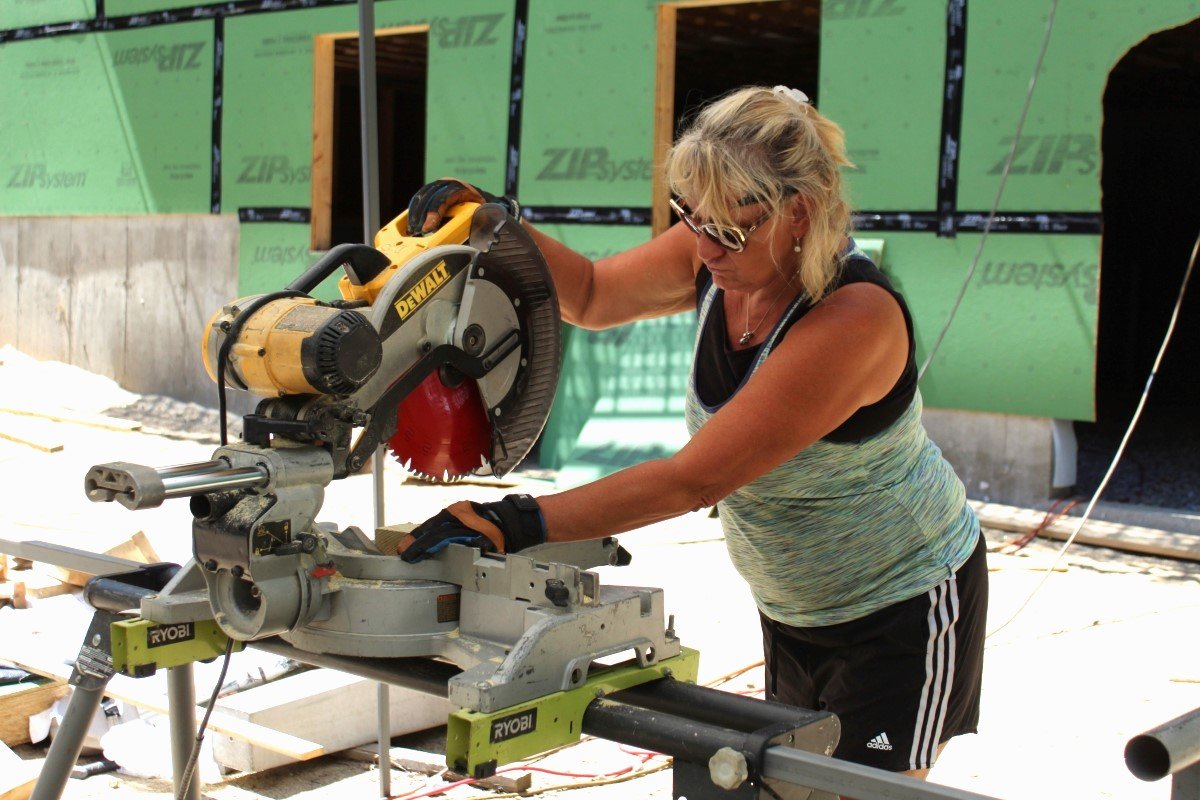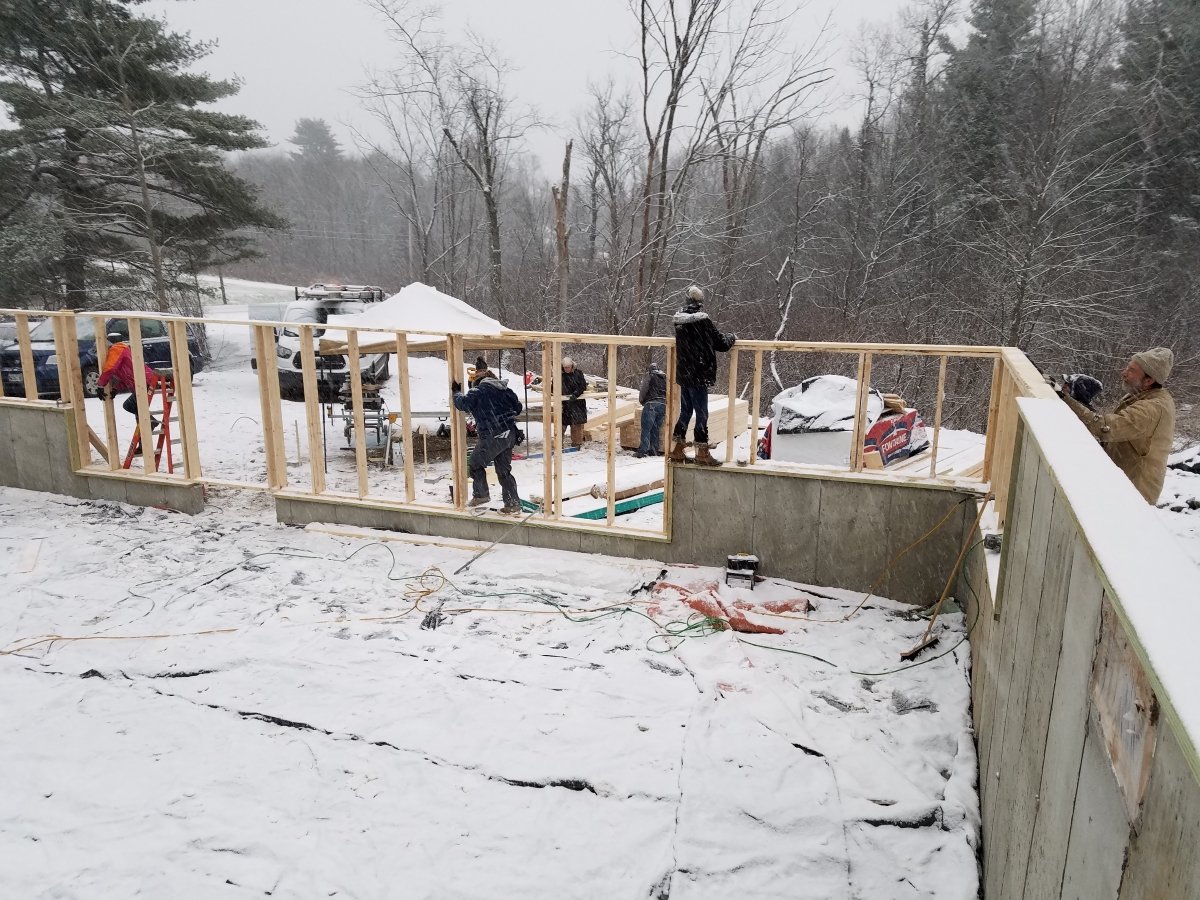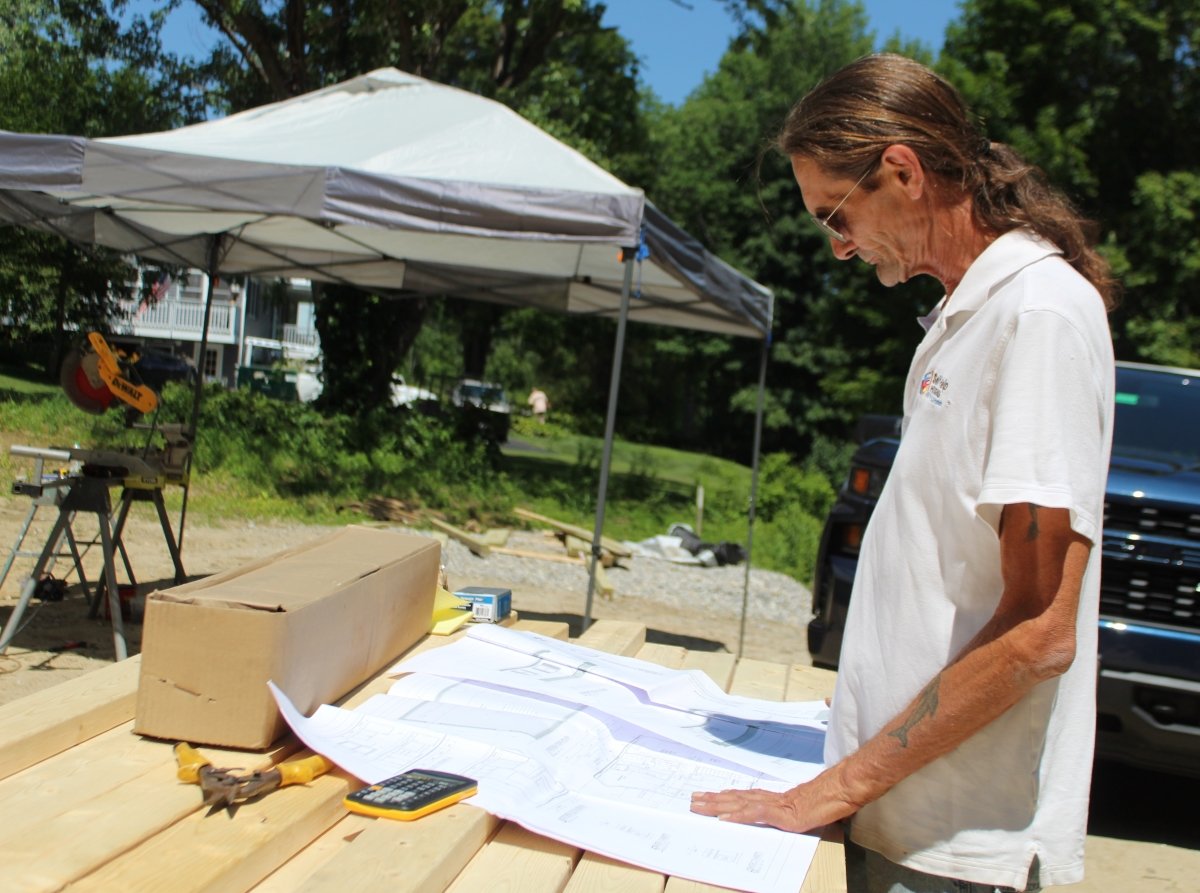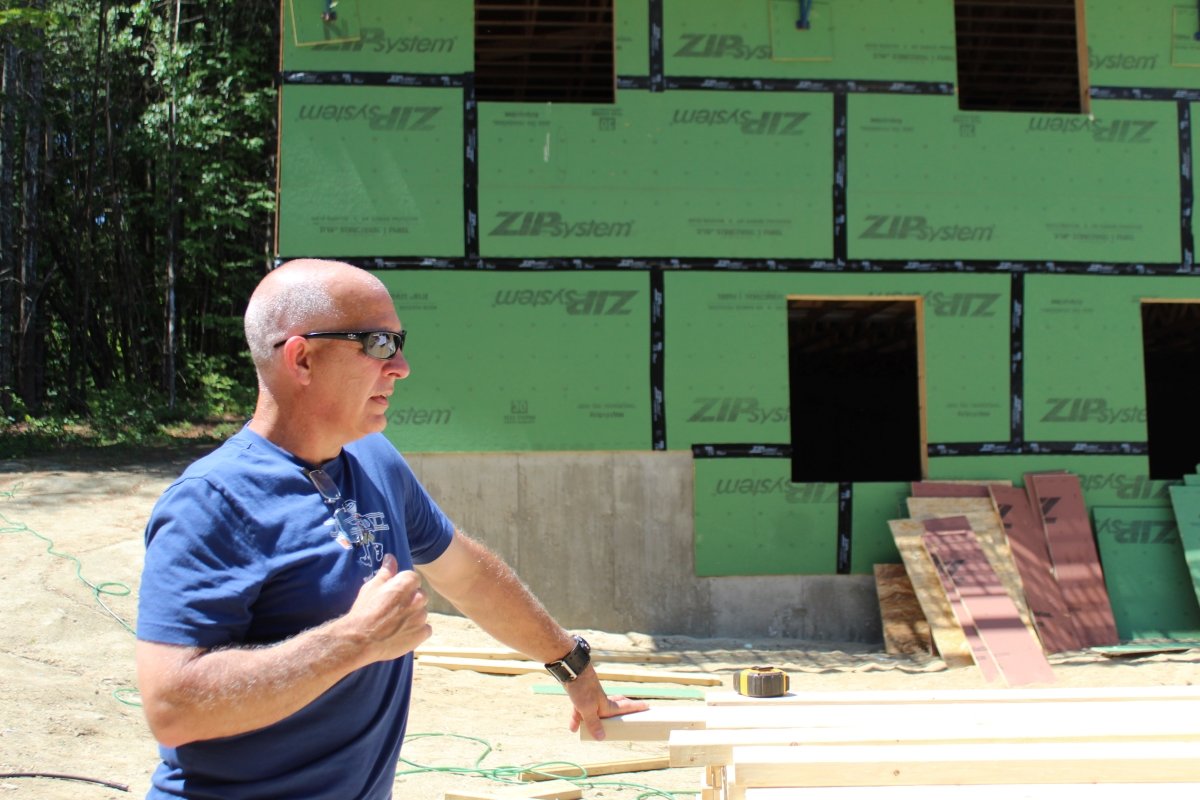Help yourself...to a house?
Karen Bates looks out on what will be her yard in rural Oxford County.
Text & photos by Amy Paradysz
Karen Bates, 56, never thought she’d be building her own home—and five others.
But that’s what she is doing this year, through Community Concepts Inc. (CCI), a Maine nonprofit that makes home ownership more affordable.
Bates has had the home ownership dream since her grown children were small. But she struggled with alcohol abuse, and her credit wasn’t up to snuff. Now nine years sober and working as a substance abuse counselor, she finds herself talking with clients about their life goals. “The last little thing on my list of goals was to own my own home,” Bates says. “I had worked on my credit and was close to being able to do it financially. But the market was so crazy.”
To bridge that gap, Bates is participating in CCI’s Self-Help Home Ownership program with five other soon-to-be homeowners building ranch-style houses in western and central Maine.
“I sometimes feel like the old mother hen of the group, but I can keep right up with them,” she says. “It’s a huge commitment, every Saturday and Sunday for a year. But think how fast a year goes by.”
The concept is simple: CCI scouts for land that interests a potential homeowner and, if all goes well, gets them approved for a Rural Development Loan. Excavation experts are brought in. And then the homeowner meets five other strangers about to go through the same life-changing experience. Site supervisor Ken Irons, who has been through this about 50 times, tells the group how the next 12 or more months will go.
Picture something halfway between an Amish barn raising and a reality television homebuilding boot camp—with fewer cameras but not always less drama.
“A lot of these folks have full-time jobs and kids, and they’re trying to work two 10-hour days every weekend,” says CCI Manager Michael Sampson. “And they’re working outside in the sun and the heat, sometimes rain or cold and snow.”
On the other side of the ledger: no down payment is required. To qualify, the homeowner needs an annual income of at least $37,000, and there’s an income cap; in Oxford County, for example, it’s $57,300 for a family of four. With CCI, the homeowner gets more house than they might have otherwise been able to afford, at an interest rate of 3.5% or even lower, depending on income. And it’s a new, energy-efficient house. They can also get a longer loan term—either 33 or 38 years.
“It’s a great program for anyone who can qualify,” says Susan Bradford, who walks interested homeowners through the application process. Participants have significant equity by move-in day. In the last build cohort, the homes appraised at about $235,000. Mortgages averaged about $165,000. That’s an average of $70,000 in equity for one very long, hard year of working weekends.
“They’re framing, roofing and siding the house,” Sampson says. “They’re painting. They do their own insulation with blown-in cellulose. They build their own decks—one on the side and one in the back. And they do some landscaping, seeding and haying and raking out their lawn.”
The clients do all this work as a group, and they do it six or more times—once for everyone in the program. No one moves in until the whole “build” is complete, and all houses pass inspection.
Gallery: 1. Working on her future home and five others, Karen Bates has learned to do things she never imagined herself doing. 2. Community Concepts cohorts work every weekend, regardless of weather. 3. Site manager Ken Irons reviews the plans for Karen Bates’ house in Oxford County. 4. Community Concepts manager Mike Sampson, who has a background as a builder, oversees all the “moving parts” of six simultaneous homebuilding projects in different towns, with most of the work being done by soon-to-be homeowners who often have no construction experience.
“They’ve been building a version of the ranch house since the 1990s,” says Emily Mottram, an architect and energy consultant. She works with CCI to update the plans as building codes change or more efficient approaches can be achieved by the homeowners building their own homes. This attention to detail, she says, has a major impact on the cost-effectiveness of the homes in the long term, including heating with a direct-vent combination gas boiler for heat and domestic hot water.
It’s been about a decade since CCI stopped building ENERGY STAR-certified homes, but Sampson says they are still practicing the same methods to make energy-efficient homes, just forgoing the expensive certification process. Basements are insulated with vinyl on both sides, attics are insulated with 18–19 inches of blown-in cellulose, and every nook and cranny between floors is filled.
There are a lot of moving parts involved in building a house, never mind building six houses—potentially in six different towns—with a team of weekend volunteers.
“But it has become a formula, broken down into stages,” Sampson says. “It’s either a righthand house with a kitchen door on this end and the bedrooms on the other, or the mirror image of that, depending on the land and where we’re going to put the driveway. The foundation changes depending on the lay of the land and whether we can put in a walkout basement.”
Each house has three bedrooms with a full common bathroom and a “3/4 bath”—one with a shower but no tub—attached to the primary bedroom. The ground floor is 1,232 square feet with a living room and a combined kitchen/dining room. The homeowner gets to make some choices along the way, selecting siding, cabinets, flooring and colors for their walls.
Some locations—like Bates’—allow for a walk-out basement. Bates says that her 19-year-old son, a bank teller, wants to finish the basement. And her grandchildren, ages 6, 5 and 2, are excited about their guest bedrooms upstairs.
“Some people have said I’m crazy for doing this at my age,” Bates says. “But why not, if I’m able to do this and have an investment? And this whole year we build, we are growing equity.”
Sometimes she stops by her property in Norway, looking out of the holes in the framing that will one day be her windows.
From start to finish, Bates and her family members pitching in will have invested about 2,400 hours into the community build.
“On moving day, we go around from house to house, with a route and a schedule to go through the final inspection,” Irons says. “They can have a U-Haul in their driveway, but nobody can move anything into the house until the lockbox is off the door and they sign the closing documents for their mortgage.”
CCI celebrated its 30th anniversary this summer. Over the past three decades, they have helped 267 Maine families build their own homes. They also have a purchase-and-rehab program through which they have helped 114 families with fixer-uppers. The program covers Androscoggin, Cumberland, Franklin Kennebec, Oxford, Sagadahoc and York counties, and the land must qualify as “rural.”
For more information: ccimaine.org/self-help-home-ownership
With attention to energy-efficiency details, Community Concepts builds three-bedroom homes like this one in Hiram. Courtesy photo.
This article appeared in the Fall 2022 edition of Green & Healthy Maine HOMES. Subscribe today!
Find Maine experts that specialize in healthy, efficient homes in the Green Homes Business Directory.

